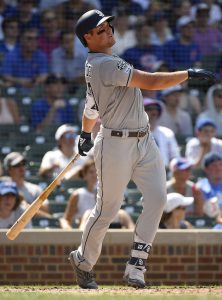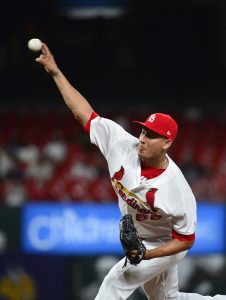It has only been a little over five weeks, so it’s too soon to judge with finality how this year’s trade deadline maneuvers will play out. That said, we’re already half of the way through the period — the regular season portion, at least — for which rental players were acquired. Even players with future control are usually added first and foremost for their immediate contributions (though there are some exceptions). It’d be awfully premature to say anything conclusive about the prospect side of any deals, but we do now have some additional information with which to work.
So, that’s why we’re going to take a glance back over our shoulders at the moves (and major non-moves) that organizations made in the run-up to this year’s trade deadline. We already covered the AL Central, NL Central, AL East, and NL East. Now we’ll head out west, starting with the American League …
Astros
The runaway division leaders were already setting up for the postseason at this summer’s trade deadline. As has now become customary, GM Jeff Luhnow pulled a rabbit out of his hat. He came through this year with the summer’s biggest blockbuster.
The Astros’ acquisition of veteran righty Zack Greinke seemingly came out of nowhere, breaking at the last possible moment. But how does it look at this early stage? The 35-year-old Greinke hasn’t been quite as good as he had been in Arizona, but he’s certainly getting the job done as hoped. Through seven starts, he carries a 3.32 ERA. On the prospect side, we haven’t learned much that we didn’t know already. Corbin Martin is still early in his Tommy John recovery, while J.B. Bukauskas only made two starts after the swap. Seth Beer did struggle upon moving to the Snakes’ Double-A affiliate, slashing .205/.297/.318 in 101 plate appearances, though that only puts a bit of a damper on a promising overall campaign. Infielder Josh Rojas, the least-hyped player involved, went on an unreal tear at Triple-A to earn a call-up. He’s holding his own (.250/.337/.382) through 86 MLB plate appearances.
That one will take longer to assess, particularly with regard to what was lost for the Houston org. That’s also true of the team’s other big deal, though in that case the initial results have been a dud for all involved. The Astros were clearly positioned to utilize outfielder Derek Fisher as a trade asset with little need for him, so turned him into a buy-low opportunity on Aaron Sanchez, who came over with reliever Joe Biagini from the Blue Jays. Fisher has not been hitting in Toronto, but the ’Stros have also not gotten anything close to what they might’ve hoped from their side of this bargain. Sanchez tantalized with a gem of an outing but couldn’t sustain it and ended up requiring shoulder surgery (the full details of which remain unclear). Biagini has not thrived after making changes to his repertoire, having now allowed a dozen earned runs and six long balls with a miserable 9:7 K/BB ratio over 13 2/3 innings.
The other MLB piece added has worked out quite nicely. The Astros brought back veteran backstop Martin Maldonado for another run. Acquired for his defense, he has also provided a whopping .246/.319/.585 hitting output over 72 plate appearances. It has been quite the opposite experience for the Cubs, who added utilityman Tony Kemp in the deal. Kemp has just nine base knocks (two for extras) in his 64 trips to the plate with Chicago.
Houston’s other deals were of the roster-clearing variety. The club sent out backstop Max Stassi to make way for Maldonado. Stassi has managed just three hits in 49 trips to the plate with the Angels; it’s still anyone’s guess whether the Astros have anything in the very young outfielders (Rainier Rivas and Raider Uceta) acquired in the deal. Neither do the ’Stros miss Tyler White, who struggled with the Dodgers before getting hurt after being sent there following a DFA. The young reliever added in that deal, Andre Scrubb, continued to show much the same results as before the swap. He ended his season with 64 2/3 Double-A innings of 2.78 ERA pitching with 10.6 K/9 and 4.6 BB/9.
Athletics
To the surprise of nobody, the A’s went for arms over the summer. While the club was rightly pleased with its overall position-player mix, there was an obvious dearth of talent in the staff — the rotation, in particular.
First came Homer Bailey, who held particular appeal since he’d cost only the league-minimum salary. (The Dodgers owe the rest of the tab on Bailey’s extension.) The 33-year-old has eaten innings as advertised, with a 4.98 ERA and 50:11 K/BB ratio over 56 frames. Oakland can’t really have hoped for much more. Infielder Kevin Merrell had been struggling when he was sent to K.C. in the deal and continued to do so after, slashing just .235/.278/.313 in 176 Double-A plate appearances.
The A’s have had much better results from the other starter they picked up, Tanner Roark, who was added in exchange for outfield prospect Jameson Hannah. While his peripherals look much like those of Bailey, Roark has held opposing teams to 3.40 earned runs per nine in his 42 1/3 frames over seven starts. Hannah — like Merrell, one of the team’s loftier recent draft choices — trended down after changing uniforms. He slashed just .224/.325/.299 in 78 trips to the plate at the High-A level.
Oakland swung one other deal with the Royals, giving up prospects Ismael Aquino and Dairon Blanco in exchange for southpaw Jake Diekman. The veteran reliever hasn’t generated the hoped-for results, compiling just 11 strikeouts while issuing nine walks over 14 1/3 innings. Blanco has scuffled mightily since the deal, while Aquino remains a total wild card.
You might’ve liked to see a bit more talent come in to the Oakland org, which surely could have stood to add more and/or better pitching pieces. But it’s hard to fault a somewhat conservative course when only a Wild Card was realistically in play.
Rangers
It remains to be seen whether the Texas organization will regret the decision not to move Mike Minor and/or Lance Lynn. Both still look like very nice values now and in the near future. For a team with hopes of a reasonably competitive reset, it was understandable that they held onto these free-agent hits. An offseason deal could yet also be considered. But it’ll be tempting to Monday-morning QB the decision if one or both falter.
The Rangers still look to have added some nice pieces in the deadline moves they did make. Veteran reliever Chris Martin brought back southpaw Kolby Allard, while high-powered but command-challenged reliever Peter Fairbanks netted utilityman Nick Solak. It was easy to part with an older bullpen piece, though Fairbanks has shown well and could still make the club pay. Still, it’s hard not to like what the Rangers have seen from their two new pieces. The 22-year-old Allard may not have an exceptional ceiling, but he has managed to carry a 3.78 ERA through six MLB starts. And Solak has a ridiculous .347/.460/.556 slash through his first 87 trips to the dish at the game’s highest level.
We’ll have to wait to see whether the team gets anything out of veteran reliever Nate Jones (if it exercises an option over him), but taking on his salary via trade allowed the Rangers to add a major international target. That deal did cost two rookie ball pitchers. Joseph Jarneski struggled quite a bit after the swap; while Ray Castro put up solid numbers, he’s already 22 years of age and is still pitching in the Dominican Summer League. The Texas organization has also received 10 1/3 solid innings from righty Ian Gibaut, who was added for a song and could be a part of the bullpen mix in 2020.
Angels
[ENTRY BLANK]
Just kidding. But … yeah, not much action for the Halos, was there? The aforementioned Stassi was added on the heels of even smaller acquisitions of along with Josh Thole (link) and Adam McCreery (link). These moves haven’t really cost much and helped the club make it through the season, but that’s about it.
To be fair, the Angels did not have a ton of obvious trade pieces to work with. Kole Calhoun would’ve held appeal, and perhaps in retrospect should have been dealt, but it’s not clear he’d have brought back enough of a return to justify sacrificing what was then an outside chance at a Wild Card run.
Mariners
There’s always some action when GM Jerry Dipoto is involved. But there could have been more. Dee Gordon was and is a candidate to be moved, as the M’s have no qualms about eating salary when necessary. Mitch Haniger might have been an interesting candidate for a big swap but for an injury. Domingo Santana was also not a factor for similar reasons.
The club did end up making several moves that brought in a volume of prospects. Cashing in veteran slugger Edwin Encarnacion in June netted pitching prospect Juan Then, who got his start in the Seattle system. The 19-year-old worked to a 2.98 ERA with 8.9 K/9 and 2.4 BB/9 over 48 1/3 total minor-league frames after the swap, topping out at the Class A level.
In a pair of deals, the Mariners sent relievers Hunter Strickland (link) and Roenis Elias (link) to the Nationals for a series of prospects. Elvis Alvarado had been walking more than a batter per inning before the move but recorded a 13:3 K/BB ratio in a dozen rookie frames thereafter. And Taylor Guilbeau showed enough to get a late call-up. He owns a 4.50 ERA in eight innings over 11 appearances. More importantly, he’s showing well against left-handed hitters … though righties have had no trouble. The third hurler added from the D.C. organization is Aaron Fletcher, a recent 14th-round pick who could soon be on the MLB relief radar. He ran up the Nats ladder with good numbers and ended the season with a 13-inning Double-A run with the Seattle organization, over which he compiled a 3.46 ERA with a 15:3 K/BB ratio.
After a long time trying, the Mariners also found a home for veteran righty Mike Leake, whose no-trade rights complicated matters. Seattle was only able to offload $6MM of salary while picking up infielder Jose Caballero. The M’s gave him a look at the High-A level, where he slashed just .256/.339/.333 over 109 plate appearances. The only other Seattle swap was a minor one. Shipping Kris Negron to the Dodgers netted a younger utilityman in Daniel Castro. He continued to struggle at the plate at Triple-A after the deal.



